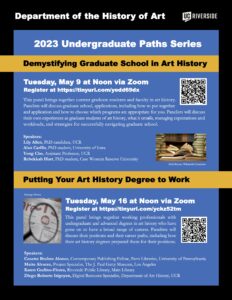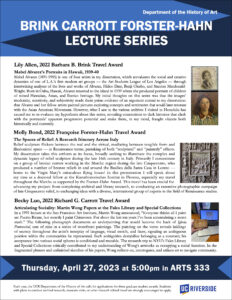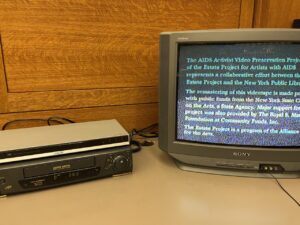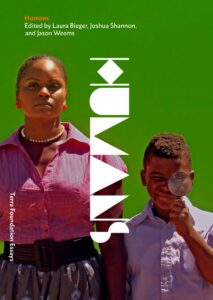Join Us for the 2023 Undergraduate Paths Series!
 Demystifying Graduate School in Art History
Demystifying Graduate School in Art HistoryTuesday, May 9 at Noon via Zoom
Register at https://tinyurl.com/yedd69dx
This panel brings together current graduate students and faculty in art history. Panelists will discuss graduate school, applications, including how to put together and application and how to choose which programs are appropriate for you. Panelists will discuss their own experiences as graduate students of art history, what it entails, managing expectations and workloads, and strategies for successfully navigating graduate school.
Speakers:
Lily Allen, PhD candidate, UCR
Alan Carillo, PhD student, University of Iowa
Yong Cho, Assistant Professor, UCR
Rebekkah Hart, PhD student, Case Western Reserve University
Putting Your Art History Degree to Work
Tuesday, May 16 at Noon via Zoom
Register at https://tinyurl.com/yckz52tm
This panel brings together working professionals with undergraduate and advanced degrees in art history who have gone on to have a broad range of careers. Panelists will discuss their positions and their career paths, including how their art history degrees prepared them for their positions.
Speakers:
Cosette Bruhns Alonso, Contemporary Publishing Fellow, Penn Libraries, University of Pennsylvania
Maite Alvarez, Project Specialist, The J. Paul Getty Museum, Los Angeles
Karen Gudino-Flores, Riverside Public Library, Main Library
Diego Roberto Irigoyen, Digital Resource Specialist, Department of Art History, UCR




 Jesse Rocha, 2021 Richard G. Carrott Travel Award
Jesse Rocha, 2021 Richard G. Carrott Travel Award Homer Charles Arnold, 2021 Françoise Forster-Hahn Travel Award
Homer Charles Arnold, 2021 Françoise Forster-Hahn Travel Award HUMANS
HUMANS Although urban dwellers would have had to contend with the inconveniences associated with large-scale municipal projects, they also would have witnessed the engineering of new landscapes and the speed with which steel beams, poured concrete and panes of glass were assembled into museums, apartment blocks, and recreational buildings. It was in this visual context that some began to question the ontological limits of the art object and conceptualize projects at the scale of the newly built environments. In Lygia Clark’s work from the mid-1950s, she proposed moving her geometric compositions from the easel to the interior walls of the modern buildings under construction, documenting her environmental compositions with architectural maquettes in 1956. She went so far as to renounce her career as an artist—temporarily — while campaigning for the integration of visual art and architecture. Similarly, Abraham Palatnik also wanted to visually activate these new interior spaces, although for him it happened with colored light. Utilizing his training as a mechanical engineer, he built mechanized light boxes that projected a sequence of chromatic compositions generated by a system of pulleys, gears, levers, and lightbulbs contained within. In São Paulo, Geraldo de Barros produced an enormous photographic series, Fotoformas (1946-1951). Like Palatnik in Rio, light was often his subject-matter, although for Barros it was the natural light refracting through different building materials and architectural features, like textured glass or open doors. Often the light and shadows are so stark that they create compositions of geometric abstraction, a phenomenon that would become increasingly common as the city became progressively vertical. This talk demonstrates some of the ways that artists reimagined the possibilities of architecture amid a building frenzy.
Although urban dwellers would have had to contend with the inconveniences associated with large-scale municipal projects, they also would have witnessed the engineering of new landscapes and the speed with which steel beams, poured concrete and panes of glass were assembled into museums, apartment blocks, and recreational buildings. It was in this visual context that some began to question the ontological limits of the art object and conceptualize projects at the scale of the newly built environments. In Lygia Clark’s work from the mid-1950s, she proposed moving her geometric compositions from the easel to the interior walls of the modern buildings under construction, documenting her environmental compositions with architectural maquettes in 1956. She went so far as to renounce her career as an artist—temporarily — while campaigning for the integration of visual art and architecture. Similarly, Abraham Palatnik also wanted to visually activate these new interior spaces, although for him it happened with colored light. Utilizing his training as a mechanical engineer, he built mechanized light boxes that projected a sequence of chromatic compositions generated by a system of pulleys, gears, levers, and lightbulbs contained within. In São Paulo, Geraldo de Barros produced an enormous photographic series, Fotoformas (1946-1951). Like Palatnik in Rio, light was often his subject-matter, although for Barros it was the natural light refracting through different building materials and architectural features, like textured glass or open doors. Often the light and shadows are so stark that they create compositions of geometric abstraction, a phenomenon that would become increasingly common as the city became progressively vertical. This talk demonstrates some of the ways that artists reimagined the possibilities of architecture amid a building frenzy. Juhn Ahn Ph.D.
Juhn Ahn Ph.D.